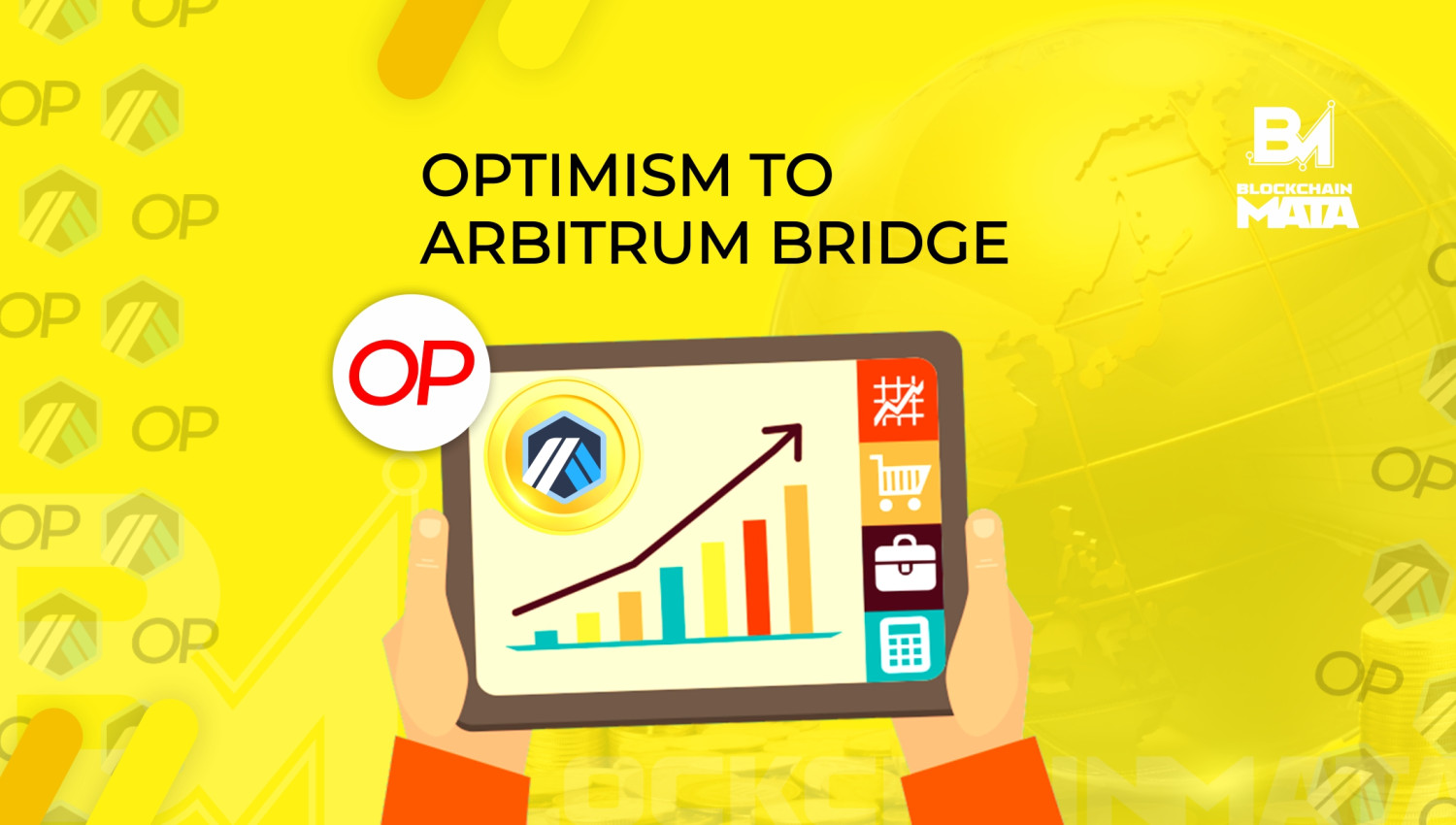Optimism to Arbitrum Bridge: Facilitating Cross-Chain Interoperability and Asset Interoperability
1 year ago By Blockchain Mata

Layer-2 scaling solutions have emerged as a popular means of addressing the scalability and cost issues that plague many blockchain networks. Two of the most popular Layer-2 scaling solutions are Optimism and Arbitrum, each with its own set of benefits and limitations. However, the use of separate Layer-2 networks can result in challenges with asset interoperability and cross-chain compatibility, limiting the usability and adoption of blockchain-based applications.
The Optimism to Arbitrum Bridge offers a solution to these challenges by providing a means of transferring assets and interacting with dApps across the Optimism and Arbitrum networks. In this article, we will explore the Optimism to Arbitrum Bridge in detail, including its functionality, benefits, and technical and security considerations.
Optimism to Arbitrum Bridge: Quick Overview
Optimism and Arbitrum are both Layer 2 scaling solutions for the Ethereum blockchain. They are designed to improve the scalability and throughput of the Ethereum network, which has been a persistent challenge due to the high demand and limited capacity of the network.
Layer 2 scaling solutions work by processing transactions off-chain, which reduces the burden on the Ethereum mainnet and improves its scalability. Optimism uses a technology called Optimistic Rollups, which allows for off-chain computation while still ensuring the security and trustlessness of the Ethereum blockchain. Arbitrum, on the other hand, uses a technology called Validium, which separates computation and storage from the Ethereum mainnet, allowing for faster and more efficient processing of transactions.
Blockchain bridging, on the other hand, refers to the process of connecting two different blockchain networks, enabling the transfer of assets and data between them. In the context of Optimism and Arbitrum, the bridge enables the transfer of assets between the two networks, allowing users to take advantage of the benefits of both solutions. The bridge uses a range of technical protocols, consensus mechanisms, and cryptographic algorithms to ensure that asset transfers are secure, reliable, and tamper-proof. The bridge also helps to increase interoperability between different blockchain networks, which is essential for the growth and development of the blockchain industry.
Why Bridge Optimism and Arbitrum?
Although Optimism and Arbitrum are both popular Layer-2 scaling solutions that offer benefits such as lower gas fees and faster transaction times, the use of separate Layer-2 networks can result in challenges with asset interoperability and cross-chain compatibility.
For example, if a user has assets on the Optimism network and wants to use them on the Arbitrum network, they would need to go through the process of withdrawing their assets from Optimism and then depositing them into Arbitrum. This process can be time-consuming, expensive, and inconvenient, limiting the usability of blockchain-based applications for end-users.
The Optimism to Arbitrum Bridge addresses this challenge by providing a means of transferring assets and interacting with dApps across the two networks. This allows for greater flexibility and usability for end-users, while also facilitating cross-chain interoperability for dApps and other blockchain-based applications.
Optimism to Arbitrum Bridge: How it Works
The Optimism to Arbitrum Bridge is a two-way bridge that allows for the transfer of assets between the Optimism and Arbitrum networks. The bridge is built on a set of smart contracts that enable users to lock their assets on one network and mint equivalent assets on the other network.
When a user wants to transfer assets from the Optimism network to the Arbitrum network, they first need to deposit their assets into the Optimism Bridge Contract. The bridge contract then mints equivalent assets on the Arbitrum network, which can be used by the user to interact with dApps and other blockchain-based applications on the Arbitrum network.
Similarly, when a user wants to transfer assets from the Arbitrum network to the Optimism network, they need to deposit their assets into the Arbitrum Bridge Contract. The bridge contract then mints equivalent assets on the Optimism network, which can be used by the user to interact with dApps and other blockchain-based applications on the Optimism network.
How to Bridge from Optimism to Arbitrum
There are different cross-chain bridges for L2 and rollups, for this article section we will be using Across Protocol. Bridging is usually straightforward, just apply the process below to other cross-chain DEX to bridge;

Across Bridge
Go to Across and connect your wallet, chose your current chain-Optimism and your destination chain-Arbitrum. Proceed to select the amount you want to bridge to Arbitrum, then cross check your input and confirm it to finalize.
Use Cases for the Optimism to Arbitrum Bridge
The Optimism to Arbitrum bridge enables the transfer of assets between the two Layer 2 scaling solutions for Ethereum, which can have a range of potential use cases in the DeFi ecosystem. Here are some examples of potential use cases for the bridge:
Cross-chain swaps: With the Optimism to Arbitrum bridge, it becomes possible to swap assets between the two networks without having to go through the Ethereum mainnet. This can enable faster and more cost-effective swaps, which can help to improve the efficiency of DeFi trading.
Liquidity pooling: The bridge can also facilitate liquidity pooling between Optimism and Arbitrum, allowing users to access a wider pool of liquidity for their trades. This can help to reduce slippage and improve the overall liquidity of DeFi markets.
Diversification of risk: By using the bridge to transfer assets between Optimism and Arbitrum, users can diversify their risk across multiple Layer 2 solutions. This can help to mitigate the risk of any one network experiencing issues or downtime, which could otherwise have a significant impact on users' investments.
Arbitrage opportunities: The bridge can also create arbitrage opportunities between the two networks, allowing users to take advantage of price discrepancies between Optimism and Arbitrum. This can help to increase market efficiency and liquidity.
Scalability for DeFi projects: DeFi projects can use the Optimism to Arbitrum bridge to access the benefits of both scaling solutions, allowing them to increase their capacity and throughput. This can help to improve the user experience and enable DeFi projects to reach a wider audience.
Technical Considerations
The Optimism to Arbitrum Bridge is built on a set of smart contracts that use a range of technical protocols to facilitate the transfer of assets between the two networks. The bridge contracts are deployed on both the Optimism and Arbitrum networks and use a combination of cryptographic algorithms, consensus mechanisms, and cross-chain communication protocols to ensure secure and reliable asset transfers.
One of the key technical protocols for the Optimism to Arbitrum Bridge is atomic swaps. Atomic swaps allow for the exchange of assets between the two networks without the need for a trusted intermediary. This ensures that users can transfer their assets securely and reliably, without the risk of fraud or other security vulnerabilities.
Another important technical consideration is the use of bridging tokens. Bridging tokens are used to represent the equivalent assets on the other network and are minted when assets are deposited into the bridge contract. These bridging tokens can be redeemed for the original assets once they are withdrawn from the bridge contract, ensuring that users can maintain ownership and control over their assets throughout the transfer process.
Security Considerations
Security is a critical consideration when it comes to cross-chain interoperability and asset transfers. The Optimism to Arbitrum Bridge uses a range of security protocols to ensure that asset transfers are secure and reliable. For example, the bridge contracts are audited by independent security firms to identify and mitigate potential security vulnerabilities.
In addition, the use of cryptographic algorithms and consensus mechanisms ensures that asset transfers are tamper-proof and transparent. The use of atomic swaps also reduces the risk of fraud and other security vulnerabilities by eliminating the need for a trusted intermediary.
Check out How to bridge ETH, OP, Matic and ABR
Conclusion
The Optimism to Arbitrum Bridge is an important development in the blockchain space, offering a solution to the challenges of cross-chain interoperability and asset transfers. By providing a means of transferring assets and interacting with dApps across the Optimism and Arbitrum networks, the bridge facilitates greater usability and flexibility for end-users and dApps alike.
The bridge is built on a set of smart contracts that use a range of technical protocols to ensure secure and reliable asset transfers. Security is also a critical consideration, with the bridge contracts audited by independent security firms and a range of security protocols in place to mitigate potential vulnerabilities.
As the blockchain space continues to evolve, cross-chain interoperability and asset transfers will become increasingly important. The Optimism to Arbitrum Bridge is a step towards achieving greater interoperability and usability, and we can expect to see more developments in this area in the future.



